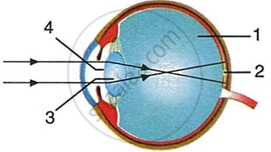Advertisements
Advertisements
प्रश्न
Explain the terms ‘adaptation’ and ‘accommodation’ with reference to the eye.
उत्तर
Adaptation is the ability to adjust vision in bright and dark areas. When we enter a dark room from bright light, the rhodopsin pigment broken down in bright light is regenerated. It dilates the pupil and allows more light to enter the eyes. This is called dark adaptation. On the other hand, if we enter bright area from a dark room, the rhodopsin pigment is bleached. This constricts the pupil and reduces the light entering the eyes. This is called 'light adaptation'
Accommodation is the process of focusing the eye at different distances. This is mainly brought about by a change in the curvature of the lens. When the ciliary muscles contract, the lens becomes thicker and we are able to focus a nearby object. On the other hand when the ciliary muscles relax, the lens remains stretched i.e. the normal condition and we are able to focus on distant object.
APPEARS IN
संबंधित प्रश्न
Write the importance of ciliary muscles in the human eye. Name the defect of vision that arises due to gradual weakening of the ciliary muscles. What types of lenses are required by the person suffering from this defect to see the objects clearly?
Akshay, sitting in the last row in his class, could not see clearly the words write on the blackboard. When the teacher noticed it, he announced if any student sitting in the front row could volunteer to exchange his seat with Akshay. Salman immediately agreed to exchange his seat with Akshay. He could now see the words written on the blackboard clearly. The teacher thought it fit to send the message to Akshay’s parents advising them to get his eyesight checked.
In the context of the above event, answer the following questions:-
(a) Which defect of vision is Akshay suffering from? Which type of lens is used to correct this defect?
(b) State the values displayed by the teacher and Salman.
(c) In your opinion, in what way can Akshay express his gratitude towards the teacher and Salman?
A student is unable to see clearly the words written on the black board placed at a distance of approximately 3 m from him. Name the defect of vision the boy is suffering from. State the possible causes of this defect and explain the method of correcting it.
What is the other name of old age hypermetropia?
Name any two defects of vision which can be corrected by using spectacles.
Name the body part with which the terms myopia and hypermetropia are connected.
What are the two most common defects of vision (or defects of eye)? How are they corrected?
A person suffering from the eye-defect myopia (short-sightedness) can see clearly only up to a distance of 2 metres. What is the nature and power of lens required to rectify this defect?
The defect of vision which cannot be corrected by using spectacles is:
(a) myopia
(b) presbyopia
(c) cataract
(d) hypermetropia
The near point of a long-sighted person is 50 cm from the eye.
(a) Can she see clearly an object at:
(i) a distance of 20 cm?
(ii) at infinity?
Which part of the eye is grafted in a needy patient from a donated eye?
Differentiate between members of the following pair with reference to what is asked in bracket.
Myopia and hyperopia (cause of the defect)
Name the common defects of the eye.
Give Reason:
Deficiency of vitamin A causes night blindness.
Draw a neat labeled diagram to show how hypermetropia can be rectified.
Give Technical Term:
The type of lens used to correct myopia is
Complete the following sentence with appropriate word :
An inability to focus on nearby objects due to loss of elasticity of the lens with age is called Iris.
Which of the following statement is correct?
Draw ray diagram showing myopic eye.
Complete the following table by observing the given figures:
| Figure → |  |
 |
| Points ↓ | ||
| (a) Name of the defect | ______ | ______ |
| (b) Position of the image | ______ | ______ |
| (c) Lens used to correct the defect | ______ | ______ |
Given alongside is a diagram depicting a defect of the human eye. Study the same and answer the questions that follow:
 |
- Name the defect shown in the diagram.
- Give two possible reasons for this defect.
- Name the parts labelled 1 to 4.
- Name the type of lens used to correct this eye defect.
- Draw a labelled diagram to show how the above mentioned defect is rectified using the lens named above.
